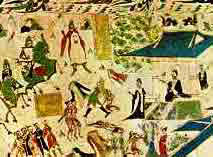|
| Related Stories |
 |
 |
|
|
Travelling information about Dunhuang  |
|
|
 Location: west of Hexi Corridor, Gansu province of China Location: west of Hexi Corridor, Gansu province of China
Neighboring Areas: Shaanxi, Sichuan, and Qinghai provinces, Inner Mongolia, Ningxia Hui and Xinjiang Uygur Autonomous Regions
Physical Features: a tiny oasis rounded by high mountains, desert and Gobi, with the average altitude of 1100 meters
Population: 100,000
Area: 3,120 square kilometers
Nationalities: Han, Hui, Tibetan, Manchu, Dongxiang, Yugu, Baoan, Mongolian, Kazak, Tu and Sala
Weather: warm variable zone, aridity climate with the frost-free period of 160 days, windy; average temperature 9.3 Celsius annually, annual or daily difference in temperature great, hot summer with the highest temperature over 40 Celsius; annual precipitation 1982.7 millimeters, concentrated in spring and autumn.
Products: Liguang Apricot, Ziyang Peach, Mingshan Dates, Yangguan Grape, Watermelon, Bailan Melon, Huanghemi Melon, Apple-pear, Apple
Local Highlights: Qinqiang Drama, Handcraft Carpet
Travel route: Silk Road
The Silk Road was a famous trade route in ancient times, taking traders through Asia and into Europe.
The road began in Chang'an, today's Xi'an, the capital of Northwest China's Shaanxi Province, and ran westward for about 7,000 kilometers through Shaanxi Province, Gansu Province, Ningxia Hui Autonomous Region, Qinghai Province and Xinjiang Uygur Autonomous Region, and then went into Afghanistan, Iran, Iraq and Syria before reaching the east coast of the Mediterranean. The section in China is over 4,000 kilometres long.
At the beginning of the tour, Xi'an's terracotta warriors offer visitors some idea of the appearance and bearing of Qin Dynasty soldiers. The Qin was China's first dynasty, established in 221 BC but was destroyed 11 years later.

Part of the Silk Road's history has been covered by the desert. The Dunhuang Mogao Grottoes, however, give visitors an insight into the history and culture of the period from the 4th-13th AD centuries.
A performance of the "Flowers and Rains along the Silk Road" will help visitors relax when they spend the night near the Dunhuang grottoes.
At the Jiayuguan Pass, travellers can see the spot where the Great Wall comes to an end, and under Yumen Pass they are encouraged to drink the region's fine wines.
In the ancient city of Loulan, travelers can pay a visit to the ruins of this small ancient Buddhist kingdom.
Accessibility to the City
In recent years, the civil aviation department and government of Dunhuang City invested more than 45 million yuan in reconstructing runway of Dunhuang airfield, widening Dunqi and Dunyue roads and the ring road in southeast of the city, constructing a road to Yumen (or Jade Gate) Pass, repairing the roads to all the scenic spots, putting special trains from Urumqi to Liuyua in peak touring period into use, opening new airlines for chartered flight from Dunhuang to the cities of Beijing, Guangzhou, Nanjing, Urumqi and Yinchuan, and adding regular buses to places of Lanzhou, Wuwei, Jinchang, Zhangye, Jiuquan, Hami, Germu and Urumqi.
Two lines of buses and all kinds of vehicles make the road traffic extend in all directions. More than 700 taxis, 1000 rickshaws and 11 taxi parking points offer passengers a great convenience for travelling.
Editor: Rebecca & Ronnie
Source: China National Tourism Administration
|
|









